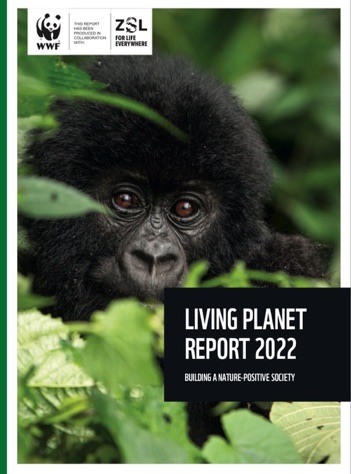News
15 October 2022
The loss of biodiversity continues, boosted by climate change, says WWF
Introduced by the WWF as ‘the most comprehensive analysis of the global state of nature’ the last Living Planet Report confirms the results from a myriad of earlier work warning the world on the seriousness of biodiversity loss [read here pp. 7-11 and here pp. 7-8].
The authors of the report rightly stress one aspect of the biodiversity issue that is often overlooked. It has to do with the link existing between loss of biodiversity, on the one hand, and ongoing climate change, on the other. It may be that the importance given to climate change in the media and in speeches by political leasers has helped to hide somewhat the persistent process leading to a decrease of biodiversity and its dramatic consequences of which the world might become aware in the future.
This link, as the authors state, is due to the impact that higher temperatures and modification of rain patterns have on ecosystems within which all the beings that make biodiversity live. Massive mortality, local and sometimes global extinction of certain species, are the consequences of these changes.
However, the report recalls that it is the conversion of land use that is the main factor of biodiversity loss by destroying the habitat in which it thrives. It is land clearing that eliminates vegetation (trees and hedges, among others) - let’s not forget that plants constitute the overwhelming part of biomass [read] - that harbours wildlife. The manner in which land is being cleared matters too (deforestation, artificialization of soils by the expansion of paved or concrete surfaces). At hungerexplained.org, we will add that production techniques used in agricultural areas also are an important factor of biodiversity destruction as the use of pesticides and synthetic fertilizers impact vegetation and wildlife whether on the surface (insects, birds, small mammals, etc.) and, in depth (earthworms, mushrooms and other microorganisms that have a key role in the soil’s biological activity and in the carbon cycle that, both, are absolutely essential in the processes on which the production of our food depends), and in water, in which part of the agrochemicals applied end up, washed away by rains.

The WWF uses the Living Planet Index of the UN that tracks the evolution of populations of some wild species over time. This is a composite index constructed from available data on the size of the population of a great number of vertebrates (mammals, birds, fishes, reptiles and amphibians) and that compiles data collected from thousands of sources [read pp. 14-16]
At global level, the Living Planet Index decreased by 69% between 1970 and 2019. In the regions, it did not fall as fast in those that have been industrialized for long (North America and Europe/Central Asia) than in those with high demographic growth and in the process of industrialization (Latin America, Africa, Asia and the Pacific). This difference is probably a consequence of a certain time lag of the mechanism leading to biodiversity loss (Fig.1).
Fig.1 Global and regional evolution of the Living Planet Index (1970-2018)

Source: Living Planet Report 2022
Note: the shaded areas around the line showing the trend of Index
represent the statistical certainty surrounding the trend.
Although it relies on an impressive database, the index is not without its weaknesses and its interpretation could be controversial. The main critiques refer to the following aspects:
-
•the index is computed on a variable database (in 2004, it included 1,100 species, in 2020 21,000 and in 2022 it had 32,000 species), which should make comparisons in time awkward;
-
•the index is computed by making a non-weighted average of growth or decline rates of the analysed species;
-
•birds and species from temperate regions are overrepresented in the sample used to compute the index [read]
-
•the index is only on vertebrates that represent only a small fraction of biodiversity (all animals, including vertebrates, weigh less than 0.5% of total biomass on Earth [read]). Insects, in particular are not being considered. In a way, it is only monitoring the tip of the biodiversity iceberg.
To sum up, the index and the report that presents it are useful to get an idea of the major trend in the evolution of vertebrates that can be regarded as relatively representative of the main ecosystems.
However, the point of view provided remains partial and does not depict an exhaustive picture of the state of biodiversity on Earth. In particular, it totally overlooks microorganisms who are known to play a key role in processes that are at the basis of the production of our food [read pp. 6-7].
On another note, the report is a new opportunity for WWF to put forward their views on a biodiversity protection approach that is based on the establishment of protected zones. Placed in the context of an ideological distinction between humanity and ‘nature’ (the environment or life, would probably be better words), the text continuously contrasts ‘natural’ areas from those used by humans, giving indirect arguments in favour of allowing the plundering of land exploited by humans, as long as protected enclaves are maintained that should cover one third of the Earth’s surface, according to WWF. This strategy, as explained elsewhere on hungerexplained.org, is a serious threat to the sustainability of humanity [read here and here].
—————————————
To know more:
-
•WWF, Living Planet Report 2022 – Building a nature- positive society. Almond, R.E.A., Grooten, M., Juffe Bignoli, D. & Petersen, T. (Eds). World Wildlife Fund, Gland, Switzerland, 2022.
-
•Wikipedia, Living Planet Index, (online).
Selection of past articles on hungerexplained.org related to the topic:
Last update: October 2022
For your comments and reactions: hungerexpl@gmail.com


